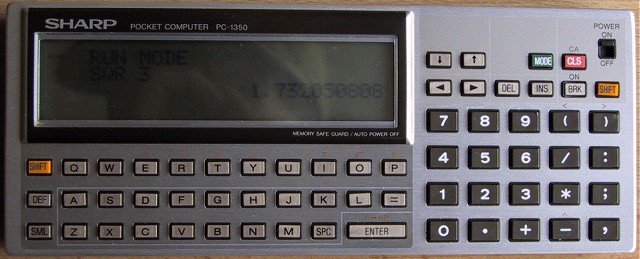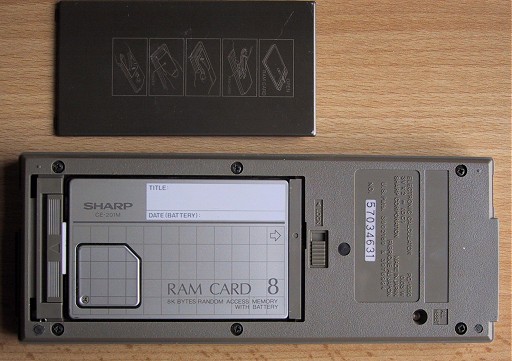sharp pc-1350
| the 1350 and 1360 are fine examples of pocket
computers. well-built and capable, the 1350 has 24x4 character display
(150x32 pixels), 40K rom and 5k built-in memory which can be expanded
using additional ram cards (see below).
although the machine is designed to be programmed in basic, it works quite well as a standalone calculator. features exist to recall and re-edit expressions as well as the convenience of a 4 line display. |
 |
the rom basic supports; strings, multi-dimension arrays, graphics, peek & poke (it has a proper memory map, 16bit), printing, save & load to cassette tape, print using (remember that?), gosub, beep and more math functions (eg asn = arc sine) than you normally get with basic (its a calculator too!)
sharp basic does not have a dynamic pool for string variables. this leads to a slightly unusual aspect of the implementation is the way character string work and the namespace for variables. variables A-Z are pre-allocated and can be either numeric or strings, but if strings, they can contain only 7 characters (the memory of 1 number). other variables have to be created with DIM. by default, string variables are 16 characters. new variables take 2 character names like AA, AA$ or A1$ etc. however you can dimension the existing names into new variables. eg DIM A$(10), reserve 11, 16 characters strings into A$. arrays created with DIM can be one or two dimensional. furthermore, if they are string arrays, the length of the strings can also be specified (16 is the default) as illustrated by this example, DIM A1$(5)*26. this reserves 6 strings of 26 characters into A1$. therefore, rather oddly, to make a single string longer than 16 chars would be something like; DIM A$(0)*80. 80 character strings is max and array dimensions is limited by 255. the string length specification can also be used to make strings shorter than the default in order to save memory, calculated as 7+(array dimension+1)*length bytes.
the DEF key can be used to attach programs to letters and to store text abbreviations. so normally, you might have several programs in memory and attach them to letters for quick run-mode execution.
| the back of the machine hosts the optional ram expansion
slot. this one has a 8k card (ce-201m). notice the card has its own
battery compartment so that the content is non-volatile. the 8k card expands the machine to 13k. around 11k is available for programs, quite a respectable amount. |
 |